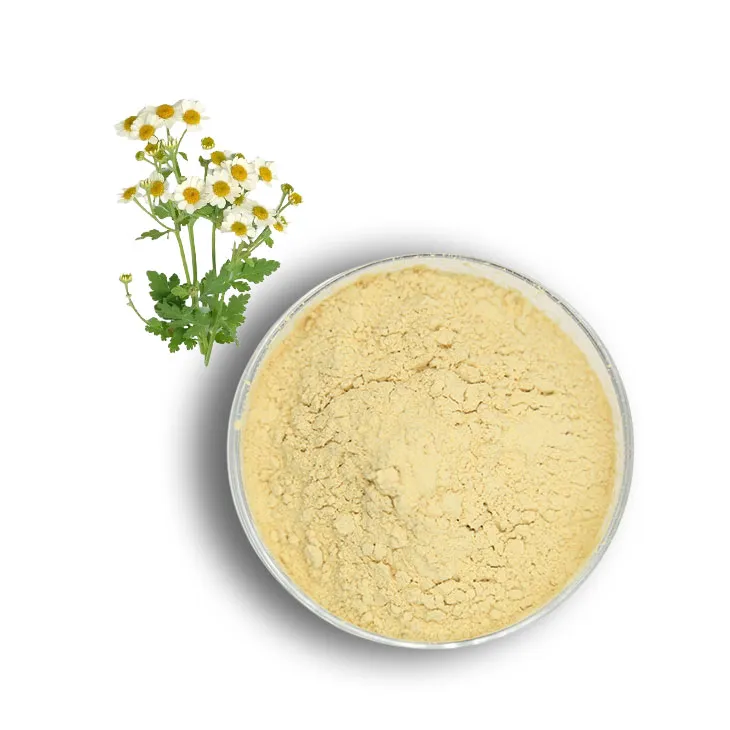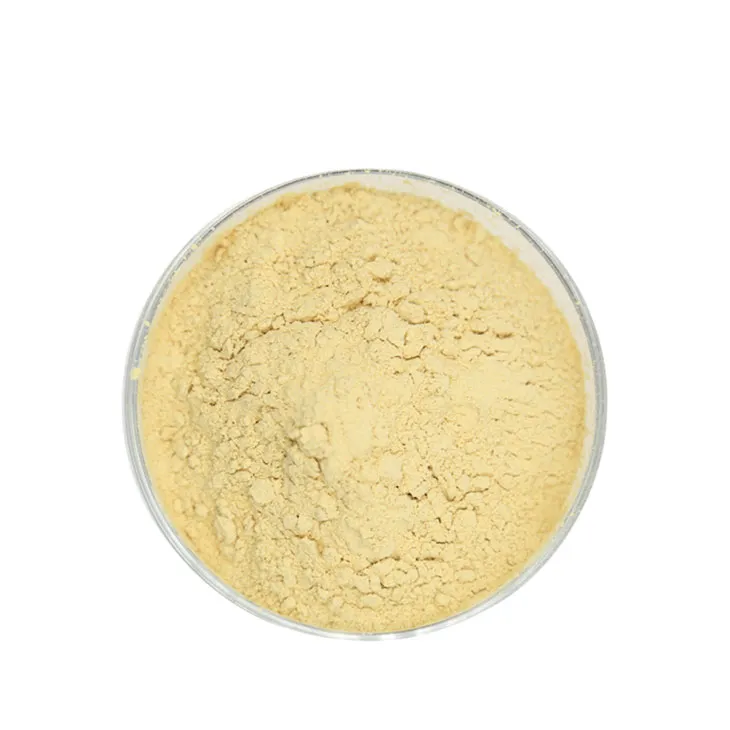- 0086-571-85302990
- sales@greenskybio.com
About Feverfew Extract: An Anti - inflammatory and Soothing Agent from Natural Feverfew.
2024-12-20

1. Introduction to Feverfew
White daisy, known scientifically as Feverfew (Tanacetum parthenium), is a herbaceous plant that has been used for centuries in traditional medicine. It is native to parts of Europe and Asia but has now spread to other regions as well. The plant is characterized by its small, white, daisy - like flowers and fern - like leaves. Feverfew has a long - standing reputation for its medicinal properties, and one of the most important components derived from it is the Feverfew Extract.

2. The Anti - inflammatory Properties of Feverfew Extract
Inflammation is the body's natural response to injury or infection. However, chronic inflammation can lead to a variety of health problems. Feverfew Extract contains several compounds that have been shown to possess anti - inflammatory properties.
2.1 Sesquiterpene Lactones
One of the key groups of compounds in Feverfew extract are the sesquiterpene lactones. These compounds are believed to be responsible for much of the extract's anti - inflammatory action. They work by inhibiting the production of certain inflammatory mediators in the body, such as prostaglandins and leukotrienes. By reducing the levels of these mediators, Feverfew extract can help to decrease inflammation at the site of injury or in inflamed tissues.
2.2 Flavonoids
Feverfew also contains flavonoids, which are another class of compounds with anti - inflammatory effects. Flavonoids are known for their antioxidant properties as well, which can further contribute to the overall anti - inflammatory action of the extract. They help to neutralize free radicals in the body, which can otherwise cause oxidative stress and inflammation. The combination of sesquiterpene lactones and flavonoids in Feverfew extract makes it a potent anti - inflammatory agent.

3. Soothing Effects on Skin Inflammation
Skin inflammation can be caused by a variety of factors, including allergens, irritants, and infections. Feverfew extract has shown great potential in soothing skin inflammation.
3.1 Topical Application
When applied topically, Feverfew extract can penetrate the skin and reach the inflamed areas. It can reduce redness, swelling, and itching associated with skin inflammation. For example, in cases of eczema or dermatitis, where the skin is often itchy, red, and inflamed, Feverfew extract - based creams or ointments may provide relief. It helps to calm the irritated skin cells and promotes the healing process.
3.2 Anti - microbial Activity
In addition to its anti - inflammatory properties, Feverfew extract also has anti - microbial activity. This is beneficial in cases of skin inflammation caused by bacterial or fungal infections. By inhibiting the growth of these microorganisms, the extract can help to clear the infection and reduce the associated inflammation. It can be used in combination with other anti - microbial agents in skincare products to enhance their effectiveness.

4. Alleviating Minor Internal Inflammations
Internal inflammations, such as those in the digestive tract or joints, can also be alleviated by Feverfew extract.
4.1 Digestive Tract
In the digestive tract, inflammation can be caused by factors like diet, stress, or infections. Feverfew extract can help to soothe the inflamed tissues in the digestive system. It may reduce symptoms such as abdominal pain, bloating, and diarrhea associated with digestive tract inflammation. Some studies suggest that it can also help in cases of inflammatory bowel diseases, although more research is needed in this area.
4.2 Joint Inflammation
For joint inflammation, such as in arthritis, Feverfew extract may offer some relief. It can reduce pain and swelling in the joints by its anti - inflammatory action. Although it may not be a substitute for traditional arthritis medications, it can be used as a complementary therapy. It may work by reducing the production of inflammatory chemicals in the joint tissues, thereby improving the symptoms of joint inflammation.

5. The Growing Interest in Natural Solutions
In recent years, there has been a significant increase in the interest in natural solutions for health and wellness. People are becoming more aware of the potential side effects of synthetic drugs and are looking for alternatives. Feverfew extract fits well into this trend as a natural anti - inflammatory and soothing agent.
5.1 Consumer Preferences
Consumers are increasingly choosing products that contain natural ingredients. In the skincare market, for example, products with Feverfew extract are becoming more popular. People prefer these products as they believe that natural ingredients are gentler on the skin and less likely to cause allergic reactions. Similarly, in the field of herbal remedies, Feverfew extract is being incorporated into various formulations for its anti - inflammatory and soothing properties.
5.2 Sustainability and Environmental Concerns
Another factor driving the interest in Feverfew extract is the growing concern for sustainability and the environment. Since Feverfew is a plant - based ingredient, it is often perceived as more sustainable compared to synthetic chemicals. The cultivation of Feverfew can also be done in an environmentally friendly manner, which further adds to its appeal.

6. Potential Applications of Feverfew Extract
Feverfew extract has a wide range of potential applications due to its anti - inflammatory and soothing properties.
6.1 Skincare Products
As mentioned earlier, Feverfew extract can be used in various skincare products. It can be found in creams, lotions, serums, and masks. These products are designed to target different skin conditions, such as acne, rosacea, and aging skin. For acne - prone skin, the anti - inflammatory properties of the extract can help to reduce the redness and inflammation associated with pimples. In rosacea, it can soothe the flushed and inflamed skin. And for aging skin, it can help to reduce inflammation - related damage and promote a more youthful appearance.
6.2 Herbal Remedies
In herbal remedies, Feverfew extract can be used in the form of tinctures, capsules, or teas. It can be used to treat a variety of ailments related to inflammation, such as headaches, menstrual cramps, and muscle soreness. For headaches, it may work by reducing the inflammation in the blood vessels in the head. In menstrual cramps, it can help to soothe the inflamed uterine muscles. And for muscle soreness, it can reduce the inflammation in the muscle tissues after exercise or injury.
6.3 Nutritional Supplements
Feverfew extract can also be included in nutritional supplements. These supplements can be taken daily to support overall health and well - being. They can help to maintain a healthy inflammatory response in the body, which is important for preventing chronic diseases. However, it is important to note that the use of nutritional supplements should be done under the guidance of a healthcare professional.
7. Conclusion
White daisy (Feverfew) extract is a remarkable natural substance with significant anti - inflammatory and soothing properties. Its potential applications in skincare, herbal remedies, and nutritional supplements make it a versatile and valuable ingredient. As the demand for natural solutions continues to grow, Feverfew extract is likely to gain even more attention in the future. However, further research is still needed to fully understand its mechanisms of action and to explore its potential in treating various health conditions. Overall, Feverfew extract stands as a promising natural agent in the pursuit of health and wellness.
FAQ:
What is white daisy (feverfew) extract?
White daisy, or feverfew, extract is a substance obtained from the feverfew plant. It is highly regarded in natural therapeutics as it contains anti - inflammatory agents that can help with both internal and external inflammations, and is also effective in soothing discomfort.
How does white daisy (feverfew) extract work as an anti - inflammatory?
The exact mechanisms are still being studied. However, it is known that the extract contains certain compounds that can interact with the body's inflammatory response pathways. These compounds likely help to reduce the production of inflammatory mediators, thereby alleviating inflammation.
What are the potential applications of white daisy (feverfew) extract?
Its potential applications are quite diverse. In skincare, it can be used to address skin inflammation. In the field of herbal remedies, it can be used for minor internal inflammations. Overall, it can be incorporated into various products such as creams, ointments, and herbal teas.
Is white daisy (feverfew) extract safe for use?
When used properly, it is generally considered safe for most people. However, some individuals may be allergic to it. As with any natural remedy, it is advisable to do a patch test before using it extensively, especially in skincare applications. Pregnant or breastfeeding women should also consult a healthcare provider before using it.
How can white daisy (feverfew) extract be obtained?
It is typically obtained through a process of extraction from the feverfew plant. This may involve using solvents to draw out the active compounds. However, commercially available extracts are often standardized for quality and potency, and it is recommended to use these rather than attempting to make one's own extract at home without proper knowledge and equipment.
Related literature
- The Anti - Inflammatory Properties of Feverfew: A Review"
- "Feverfew Extract in Skincare: New Insights"
- "Feverfew: Traditional Uses and Modern Research on its Anti - Inflammatory Activity"
- ▶ Hesperidin
- ▶ Citrus Bioflavonoids
- ▶ Plant Extract
- ▶ lycopene
- ▶ Diosmin
- ▶ Grape seed extract
- ▶ Sea buckthorn Juice Powder
- ▶ Fruit Juice Powder
- ▶ Hops Extract
- ▶ Artichoke Extract
- ▶ Mushroom extract
- ▶ Astaxanthin
- ▶ Green Tea Extract
- ▶ Curcumin
- ▶ Horse Chestnut Extract
- ▶ Other Product
- ▶ Boswellia Serrata Extract
- ▶ Resveratrol
- ▶ Marigold Extract
- ▶ Grape Leaf Extract
- ▶ New Product
- ▶ Aminolevulinic acid
- ▶ Cranberry Extract
- ▶ Red Yeast Rice
- ▶ Red Wine Extract
-
Saw Palmetto Extract
2024-12-20
-
Phellodendron Extract
2024-12-20
-
Fig Extract
2024-12-20
-
Cactus Extract
2024-12-20
-
Dandelion Root Extract
2024-12-20
-
Stevia Extract
2024-12-20
-
Boswellia Serrata Extract
2024-12-20
-
Cranberry Extract
2024-12-20
-
Motherwort Extract
2024-12-20
-
Sea buckthorn oil
2024-12-20





















